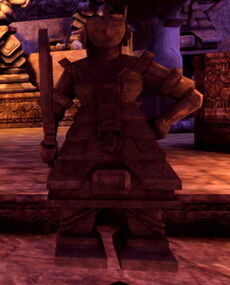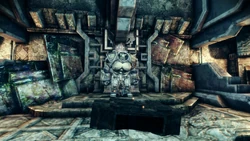(added reference) |
mNo edit summary |
||
| Line 36: | Line 36: | ||
* '''Erahel''' is a Paragon who died in [[Caridin's Cross]]. He is mentioned on a [[:File:Road Marker.png|Road Marker]]. |
* '''Erahel''' is a Paragon who died in [[Caridin's Cross]]. He is mentioned on a [[:File:Road Marker.png|Road Marker]]. |
||
| − | * '''Fairel '''is a Paragon who, along with his clan and two sons, escaped the conflicts waged belowground between clans, and built a new thaig aboveground in |
+ | * '''Fairel '''is a Paragon who, along with his clan and two sons, escaped the conflicts waged [[Thedas#Underground|belowground]] between clans, and built a new thaig aboveground in [[the Hissing Wastes]] of western [[Orlais]].<ref>[[Codex entry: Dwarven Inscriptions: Hissing Wastes]]</ref> |
* '''[[Orseck Garal]]''' is the Paragon who moved the capital from [[Kal-Sharok]] to Orzammar.<ref>[[Codex entry: Orzammar History: Chapter One]]</ref> His statue can be found in the Hall of Heroes. |
* '''[[Orseck Garal]]''' is the Paragon who moved the capital from [[Kal-Sharok]] to Orzammar.<ref>[[Codex entry: Orzammar History: Chapter One]]</ref> His statue can be found in the Hall of Heroes. |
||
Revision as of 07:58, 16 December 2014

Statue of Paragon Branka
Paragons are the elite of the dwarven culture, the pinnacle of dwarven excellence, and the one exception to the rigid caste structure as they can be drawn from any caste, even the casteless.[1]
Background
They are the noble warriors, politicians, smiths and even children that all others seek to emulate, and they function as essential role models to all dwarves. While dwarves have no gods, a Paragon is like a god in the eyes of dwarves[1] which is attibuted to the fact that the dwarves venerate their Ancestors, so a living Paragon is considered as a living Ancestor. The word of a Paragon surpasses in weight even the word of a king—even if the former's title does not grant official power.[2]
Dwarven cities are decorated by monolithic lifelike statues of Paragons from days past. They are most prominent in the Hall of Heroes inside the surface gates where the giant statues appear to hold up the ceiling. This is meant to impress—and perhaps intimidate—visitors to Orzammar and to convey upon dwarves heading to the surface all that they are leaving behind.

Paragon Hirol's sarcophagus
King Endrin Stonehammer is called as the First Paragon,[3] presumably because he is considered "first among Paragons".
Election of Paragons
There are few living Paragons as many dwarves are named Paragon only after their death.[1][4] The act by which one becomes a Paragon can vary. Typically it is a feat of bravery in warfare or an incredible invention, but it can also be something as simple as embodying the ideals and tasks of one's caste to an unprecedented perfection.[1][5] However some have earned the rank for less important pursuits such as writing particularly good rhymes or brewing stronger ales.[6] A Paragon is elected by the Assembly, which is no easy feat and often involves long debate and even bloodshed.[7] When a Paragon is chosen a house is immediately created in the name of the Paragon, and their name is recorded in the Memories, the records of the dwarves.
Known Paragons
- Aeducan is the Paragon that led the defenses of Orzammar against the darkspawn when they first poured into the Deep Roads and almost completely destroyed the dwarves. It is said that his election to Paragon had but one dissenting vote; the one who cast that vote was savagely hacked to death by his fellow deshyrs,[8] allowing the election to pass unanimously. He is the founder of House Aeducan.
- Astyth the Grey is the first female Paragon of the Warrior caste. She founded the Silent Sisters, and members of that order cut out their tongue in emulation of her. At 1:95 Divine, Astyth became a Paragon when she sacrificed her life for the king.[9]
- Bemot is the founder of House Bemot and became a Paragon and king in one move during the Fourth Blight. He was born as a commoner. His statue can be found in the Hall of Heroes.
- Branka became a Paragon in 9:10 Dragon[10] and the only to be elected in four generations. She is also the founder and head of House Branka and the wife of Oghren. She's an ill-tempered smith who invented a smokeless coal. She went into the Deep Roads, taking her entire household with her save Ohgren, two years prior to the events of Blight, and has not been heard from since. She is feared dead. Her statue can be found in the Hall of Heroes.
- Child Paragon whose deeds and name are unknown, the memorial in Caridin's Cross has been worn away by time or vandalized by darkspawn.
- Caridin is the Paragon who created the Anvil of the Void. He originally descended from House Ortan but after his elevation to the Paragon status he created his own house. When he died, the secret of how to make war golems died with him.
- Erahel is a Paragon who died in Caridin's Cross. He is mentioned on a Road Marker.
- Fairel is a Paragon who, along with his clan and two sons, escaped the conflicts waged belowground between clans, and built a new thaig aboveground in the Hissing Wastes of western Orlais.[12]
- Orseck Garal is the Paragon who moved the capital from Kal-Sharok to Orzammar.[13] His statue can be found in the Hall of Heroes.
- Garen is a Paragon and a king who lived in the early Exalted Age and whose deeds are unknown. He is responsible for the sending of numerous units of the Legion of the Dead to find his outcast son within the Deep Roads.[14] Furthermore, as a tribute to his son, every heir of House Garen assumed the name Tethras.[15]
- Gherlen[16]/Gherlon[17] the Blood-Risen was born casteless. However, he ventured to the surface and after he gained enough prestige from his adventures, he returned to Orzammar and became a Paragon and king by overthrowing the previous ruler. His tale is still honored by dwarven adventurers.
- Hekkat is a paragron who discovered the means that allowed dwarves to build structures of massive height and breadth.[citation needed]
- Hirol is a Paragon who considered himself outside of the caste system and made several improvements on Caridin's original golem designs. He is also the founder of the noble House Hirol.
- Hrildan is another female Paragon who is featured in the Hall of Heroes.
- Ilona is a Paragon whose deeds are unknown, but ordered the sealing of Malvernis in the Vimmark Mountains.[18]
- Ivo is a Paragon and founder of House Ivo.[19] He must have lived during or before the Blessed Age.[20]
- Lantena is another female Paragon who is featured in the Hall of Heroes.
- Lynchcar is a Paragon who lived during the Steel Age. His deeds are not known but he is mentioned in a book of poetry.
- Moroc the Maul was a legendary warrior, present at the Grey Wardens founding in -305 Ancient (890 TE). His contribution is a key reason there is no loss of caste associated with becoming a Warden.[21]
- Ortan is a Paragon and founder of House Ortan who composed a grand epic of the Seven Brothers and the Ortanic Symphony. The Ortan Thaig is named after him.[22] His statue can be found in the Hall of Heroes.
- Seuss is a Paragon who lived in the early Glory Age. He apparently had excellent rhyming skills.
- Endrin Stonehammer: The second king of Orzammar after Garal and the most famous of the dwarven Paragons.[3]
- Tethras is a Paragon whose deeds are unknown, but who descended from the lineage of Paragon Garen. The noble house named in his honor was banished to the surface in 8:98 Blessed for fixing Proving matches.
- Varen is the Paragon who discovered that nugs are edible. He was also a former Legionnaire.[23]
- Vollney is a Paragon and founder of House Vollney whose deeds are not yet known, but it is known for becoming a Paragon by the narrowest margin in the history of the dwarves; one single vote.[24]
- The Warden of dwarven origin will become a Paragon at the end of the Fifth Blight.[25]
- Heldane Zadol: A Paragon who lived in Hormak and pioneered the art of folding steel, and whose blades are therefore coveted.[21]
Paragon Elect
After the rediscovery of Kal-Sharok, it is revealed that in a time after the kingdom was completely isolated in -15 Ancient and considered lost to the darkspawn horde[26] the dwarves of that city changed the way Paragons are worshipped and nominated as well as the type of their power. Paragon Elect is the highest elected government office. Furthermore, the practice of nominating Paragons changed from recognition of past deeds into recognition of promised deeds. In Kal-Sharok Paragons are not rendered as giant statues like Orzammar, but as massive posthumous wall carvings that span lengths of the Deep Roads.[2] The dwarves of Kal-Sharok do not recognize the Paragons of Orzammar and likewise, Orzammar does not recognize their Paragons.[27]
Notes
- During the Fourth Blight, the Siege of Marnas Pell in Tevinter Imperium took place. The dwarves assisted the Imperium in that battle and then they received many accolades by the ruling Archon. One of these dwarves also became a Paragon.[28]
References
| ||||||||||||||||||||||||

